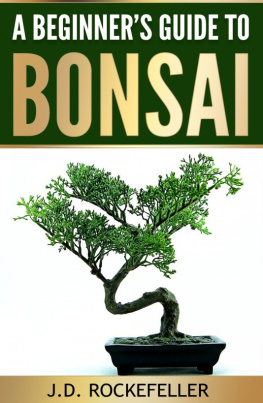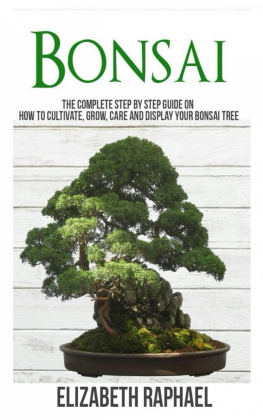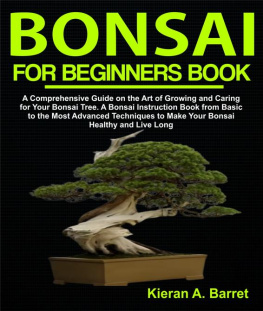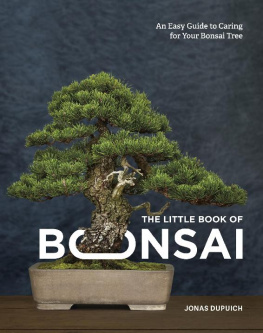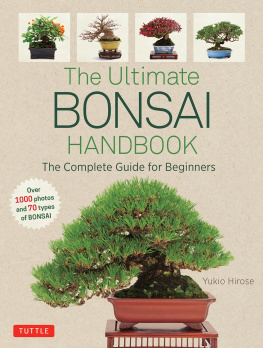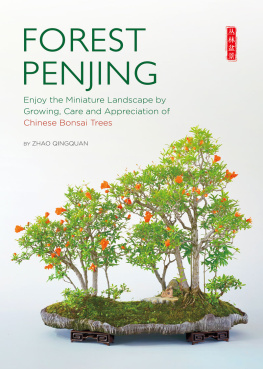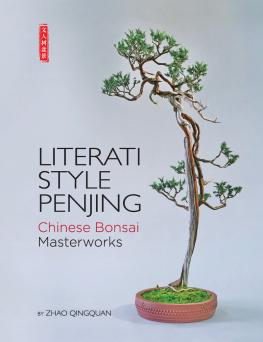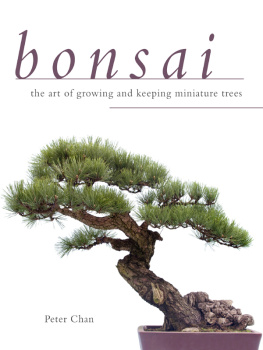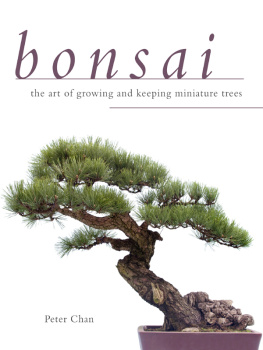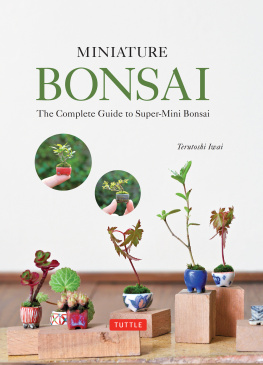BONSAI
The Complete Handbook On How To Cultivate And Take Care Of Miniature Trees
Riku Sakamoto
Text Copyright [Riku Sakamoto]
All rights reserved. No part of this guide may be reproduced in any form without permission in writing from the publisher except in the case of brief quotations embodied in critical articles or reviews.
Legal & Disclaimer
The information contained in this book and its contents is not designed to replace or take the place of any form of medical or professional advice; and is not meant to replace the need for independent medical, financial, legal or other professional advice or services, as may be required. The content and information in this book has been provided for educational and entertainment purposes only.
The content and information contained in this book has been compiled from sources deemed reliable, and it is accurate to the best of the Author's knowledge, information and belief. However, the Author cannot guarantee its accuracy and validity and cannot be held liable for any errors and/or omissions. Further, changes are periodically made to this book as and when needed. Where appropriate and/or necessary, you must consult a professional (including but not limited to your doctor, attorney, financial advisor or such other professional advisor) before using any of the suggested remedies, techniques, or information in this book.
Upon using the contents and information contained in this book, you agree to hold harmless the Author from and against any damages, costs, and expenses, including any legal fees potentially resulting from the application of any of the information provided by this book. This disclaimer applies to any loss, damages or injury caused by the use and application, whether directly or indirectly, of any advice or information presented, whether for breach of contract, tort, negligence, personal injury, criminal intent, or under any other cause of action.
You agree to accept all risks of using the information presented inside this book.
You agree that by continuing to read this book, where appropriate and/or necessary, you shall consult a professional (including but not limited to your doctor, attorney, or financial advisor or such other advisor as needed) before using any of the suggested remedies, techniques, or information in this book.
Table of Contents
Introduction
I would like to thank you for downloading this book, Bonsai: The ultimate beginners guide on how to cultivate and take care of your bonsai tree.
Do you want to know how to grow bonsai trees? How to select them and how to take care of them? Do you want to learn more about the tools you will need, and all the other basics? If your answer is yes, then you have chosen the right book!
A bonsai can be any tree that is grown in miniature using artistic techniques so it resembles an aged tree. The value of a bonsai depends on its maturity. The more mature it is, the more its potential value. You can grow different kinds of trees and train them to be bonsais. Bonsai is the Japanese word for a tree grown in a container. However, it doesnt mean that you can just place a tree in a pot and expect it to be a bonsai. You need to patiently train the trees foliage and guide it into the desired shape. You have to prune the roots to keep the tree small, wire its branches, and use other techniques to let the tree mature into a bonsai. It requires intimate care!
While learning the art of bonsai, the plethora of information out there can seem quite overwhelming. What kind of plant do you choose? How do you take care of it? How much water will it need? What about the container size? How would you prune it and so on and so forth? In this concise book, you will learn everything you need to know to grow your bonsai. So, why dont we get started?
Chapter 1: What is Bonsai?
History of bonsai
Bonsai are trees and plants that are grown in containers where their whole beauty is captured in miniature. Its an ancient technique that can be traced back to the Han Dynasty around 206 BC-220 AD. The earliest reference to bonsai as we know it today dates back to a poem from the mid-fourteenth century. However, the widespread usage didnt start until three centuries later. Pictures of bonsai are seen in scrolls that date back to 1309. This ancient practice can indeed make a person forget about their stresses and rejoice in the serenity that a simple bonsai offers.
During ancient times, bonsais were reserved for the delight of aristocrats, priests, and high-ranking individuals. It was during the seventeenth century that ordinary people started to take pleasure in them. Japan opened itself up to the western world after almost three centuries of isolation in 1868. Once it did, bonsais came to be recognized as an art form and people began to grow bonsai as a hobby. At present, bonsai-growing is a hobby that many enjoy and is a significant part of Japans art and culture.
Caring for bonsais isnt just a Japanese pastime anymore. In 1989, a World Bonsai Convention in Omiya saw more than 1200 people from 32 different countries attend the event. It goes to show the enthusiasm that people have for bonsai.
Developing and cultivating bonsai is an artistic hobby. You dont need to have a green thumb to grow bonsai; you just need practice, skill and patience. Bonsai is an excellent example of the gentle respect that the Japanese have for all living things! It requires significantly more care and commitment than a regular potted plant.
There is little restriction on the kind of plants or tree that can be turned into bonsai. Theoretically, any plant can be grown in a small container as a bonsai. The most popular options for bonsai are pines, maples, flowering trees like cherry or plum, and several other fruit-bearing trees. A bonsai is as tall as three feet or even small enough to fit in ones palm. Bonsais can be categorized depending on the shape and structure of the plant.
Common Curiosities for Bonsai
You can grow bonsai from a seed
If you really want to get the full experience of growing bonsai, you may consider starting from a seed. For those who are really committed to the process, this is much more appealing than purchasing a fully-grown bonsai then maintaining it. Of course, growing bonsai from a seed is both time-consuming and challenging. But it is more rewarding in terms of the experience you will gain from the whole process. Just make sure that you purchase the bonsai seed from a reputable source and choose the seed(s) carefully.
Buying fully-grown bonsai is more common for beginners
For those who would like to have their own bonsai, but don't think that they can grow one successfully, they have the option to purchase a plant that is already fully-grown. For such a case, you should purchase your plant from specialist bonsai growers to ensure that you're getting the best one for yourself. Do research on which shops offer fully-grown bonsai in your locale before you make a final choice.
Many people consider bonsai as an investment
Whether you plan to grow bonsai from seed or maintain a fully-grown one, you need to invest a lot of time and care into it. Think of your bonsai as an investment and the more you put into it, the more rewarding it becomes. If you're one who wants quick results, then you may want to find a different hobby.
Repotting bonsai isn't a one-time thing
As you will later on discover, it's vital to continue repotting your bonsai as it grows in vigor and size. As you see your bonsai flourish, you should re-pot it as needed. Changing your bonsai's pot is also important for its overall health and growth. Without this step, you might be hindering your bonsai from reaching its true potential.



